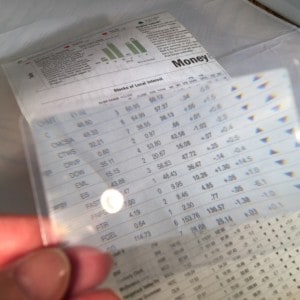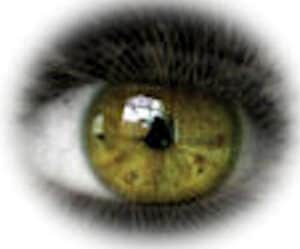Prism in lenses is not so much something ‘in’ the lenses, but it is actually how that lens is constructed, which is typically referred to as being ‘ground in.’ The presence of prisms will be seen as a thicker edge by the wearer. The thicker edge is where the base of the prism is located, and is opposite to where the image is to be shifted.
Lens materials, lens designs, and add-on tints are all options available to help you design your eye wear. Prisms are not offered as an option, but are a part of your eyeglass prescription.
What prisms do is shift the light and images observed through the lens. The prescribing doctor indicates how much the image needs to be shifted, by indicating prism diopters. The measurement also takes into account which direction the image should be shifted. Direction is indicated as ‘Base in, out, up, or down.’
This is a very simplified diagram of how prism in a lens would look if you could see it ‘ground in’ ;

The lower diagram shows how light is bent when passing through a prism. from EYE CARE Business.
There are several reasons why your eye doctor may include prism in your prescription:
- Reduce or eliminate double vision. When the eyes are not aligned in a way that creates a single fused image for the brain, there will be double vision. Prism is prescribed to shift the image to compensate for the imbalance to restore a single fused image.
- Shift the image to another part of the retina. Prisms are used when there is loss of visual field. The image is shifted from the damaged or unusable part of the retina to another retinal area so that it can be seen.
- Help with viewing close-up when using high-powered reading glasses. Those with sub-normal vision may have difficulty fusing the images seen by each eye through the very thick lenses. The prisms shift the image so the eyes can converge and fuse the two images with less eyestrain.
Fresnel Prisms (also known as Press-on Prisms)

Fresnel prisms are made of a thin flexible plastic. If you look carefully you can see ridges in the plastic. These are actually wedge-shaped lines of prism. The plastic can be cut into the shape of the eyeglass lens and applied to the surface of the eyeglass lens closest to the eye.
The top drawing shows an enlargement of the plastic sheet of prisms:

Fresnel prisms can be used on a temporary basis. The doctor may use it as a means to evaluate the patients visual function when prism is prescribed or to help a patient through a transitional period. Fresnel prisms are also used when a very large amount of prism is prescribed. So much so, that the eyeglass lens would be very thick and very heavy if traditional prism was incorporated into the lens. Therefore, press-on prisms are an alternative for high prismatic prescriptions.
The problem with Fresnel prisms is the lines of prism can degrade the vision. Looking through the prism, images will not be seen as clearly. Glare is a problem when light bounces off the lines of prism. Keep in mind, that if a lot of prism is needed, this may be the best alternative.
